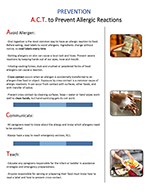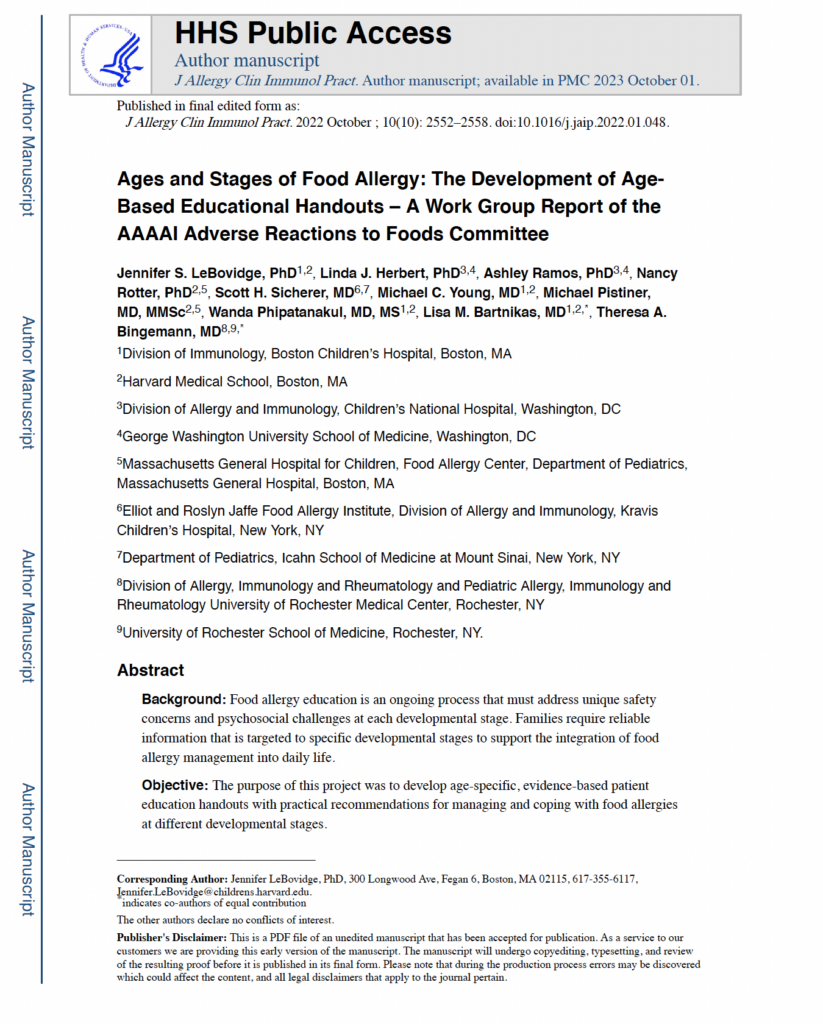×
IgE Mediated
These sections contain the same information as in the PDF handouts throughout this section, but are formatted for easier placement within EMR systems to place in after visit patient handouts.
Label Reading for Food Allergens
Read Every Label, Every Time
- You never know what’s inside a product when visually inspecting, smelling, or tasting and this can be dangerous. Label reading is the only way to know if a food is safe.
- Manufacturing, processing and ingredients of products can change at any time without giving warning.
- Anyone serving or preparing food for a child needs to know how to read a food label.
The 8 Major Allergens Are:
Milk or Dairy
Eggs
Peanuts
Tree nuts (almonds, hazelnuts, walnuts, pecans etc.)
Soy
Wheat
Fish (cod, bass, salmon, tuna etc.)
Crustacean shellfish (lobster, shrimp, crab, etc.)
Note: While the 8 major allergens are responsible for the majority of allergic reactions, ALL allergens must be taken seriously.
The Food and Drug Administration (FDA) enforces the Food Allergen Labeling and Consumer Protection Act (FALCPA) labeling law. FALCPA applies to all domestic and imported packaged foods and the 8 major allergens, which must be written in clear, plain language and labeled when in flavorings, colorings or other additives.
Note: FALCPA only applies to the 8 major allergens!
The allergens below are not included in the major 8 allergens and therefore are not included in the labeling law:
- Sesame and other seeds.
- Molluscan shellfish (oysters, clams, mussels, scallops).
The following items are not regulated by the FDA or the labeling law:
- Fresh meat and poultry products.
- Certain egg products.
- Alcoholic beverages.
- Non-food items such as lotions, and cosmetics.
- Gluten-containing grains (other than wheat barley, rye, and oats).
Major 8 Allergens Can be Listed in 1 of 2 Way
1 WITHIN THE BODY OF THE INGREDIENTS
Be aware that allergens may be written in plain language in the body of a products ingredient list.
OR
2 FOLLOWING A CONTAINS STATEMENT
A “Contains” statement:
- Only applies to the 8 major allergens.
- They are voluntary and are only present when a company chooses to add them to their label.
- These should be located immediately under the list of ingredients.
Remember “contains” statements only apply to the 8 MAJOR allergens and companies can choose to not use them.
Advisory or Precautionary Statements
- Advisory statements come in numerous formats and are not under State or Federal regulation.
- Recommendations vary by allergen, physician, child and family considerations. Talk to your healthcare provider about what to do for your child.
- If you are waiting for your pediatrician or allergist consultation, avoid foods with advisory statements as children may be sensitive to even small amount of the allergen.
- For example: May contain, made in a facility that uses or processes, made on shared equipment with, contains traces of, not guaranteed to be free of, etc.
Note: For children with celiac disease or gluten sensitivities, it may be best to look for “gluten-free products” because labeling can be inconsistent. Wheat is one of the major eight allergens, but other sources of gluten such as barley, rye and oat are not.
Cross Contact
What is Cross Contact?
Cross contact is the unplanned presence of food allergens. It occurs when an allergen protein is unintentionally transferred to an allergen free food or object. Cross contact can be invisible to the eye and can come from many places. Even small amounts of an allergen can cause an allergic reaction.
This means that your child can accidently be exposed to an allergen through:
Objects (Utensils, cooking surfaces, highchairs, pacifiers, sponges, bib, apron, etc.)
- Using the same tongs to flip shrimp and a chicken breast. Without properly washing the tongs in-between use, allergens may be transferred to the chicken breast.
Food (Steam, splatter, accidental contamination, frying oil)
- Removing nuts from a salad or scraping cheese off a cheeseburger. It is important to avoid these types of short cuts.
Saliva (People, pets, binky, Sophie the Giraffe, musical instrument, etc.)
- Sucking on another baby’s pacifier after they had a bottle of milk-based formula.
Who needs to know about allergen cross contact?
Any caregiver for your child. Babysitters, siblings, grandparents, extended family, friends, teachers, etc. Routine teaching of all caregivers about sources of cross contact and prevention of exposure is essential.
Children explore their environments with their hands and often put them, or other objects in their mouths.
Younger children are more likely to put their hands in their mouths and noses; therefore, caregivers should have increased awareness and wash their children’s hands often Avoid sharing of food, utensils, water bottles and anything else that may go in their mouth, such as musical instruments.
Cross Contamination vs Cross Contact
Cross contamination occurs when microorganisms such as bacteria contaminate food and result in a food borne illness. Unlike cross contact, the risks of cross contamination may be eliminated with proper cooking techniques, whereas proper cooking does not reduce or eliminate the chances of a food allergy reaction.
Tips for Preventing Cross Contact When Serving and Preparing Food
Preparing
- Wash your hands with soap and water after coming into contact with any allergens.
- Talk to anyone who serves or prepares food for your child as they need to understand the concepts of cross contact.
- Keep allergen free foods away from other foods while they are being stored in the refrigerator or pantry.
- Do not allow children with a food allergy to share food, drinks, plate, cups, or utensils.
- Saliva, whether from a person or a pet is another source of cross contact.
- When grocery shopping store problematic foods in a bag in your cart.
- Avoid foods in bulk bins, the deli counter, and hot and cold salad bars as these are common sights for cross contact.
Cooking
- If possible, prepare allergen-free foods first and then prepare food for the rest of the family.
- Use separate utensils and serving spoons
- Allergens cannot be destroyed by cooking, frying or freezing. Avoid foods prepared on surfaces that cannot be cleaned in-between us.
- Fried Foods (fryolators), deli slicer, seasoned wok, common grill surface.
Cleaning
- Carefully wash contact items and surfaces with soap and water or in the dishwasher before and after each use.
- Dishware, utensils, pots, pans, cutting boards, counter tops, tables, highchairs.
- Wipe down tables, highchairs, toys, pacifiers, menus, salt/pepper shakers or any other item your child could touch with their hands or put in their mouths.
- Consider carrying wipes with you and try not to rely on hand sanitizer products as they don’t fully remove food particles.
Keep it simple, limit multiple ingredient dishes, cook from scratch.
Videos for Parents for Anaphylaxis for the Infant


